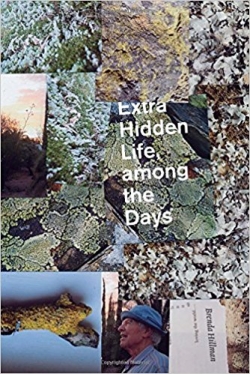Extra Hidden Life, among the Days
by Brenda Hillman
reviewed by Andrea Syzdek
Brenda Hillman’s tenth full-length poetry collection, Extra Hidden Life, among the Days, pushes the boundaries of poetic possibility. Science, activism, elegy, and ode blend in an intimate, politically conscious voice to create a flourishing poetic ecosystem. Hillman, a master poet, has received the 2014 Griffin Poetry Prize and the Northern California Book Award for Poetry as well as the 2005 William Carlos Williams Prize for Poetry. Her work is fierce but loving, risk-taking and beautiful. This collection is no exception.
The book is split into five sections: The Forests of Grief & Color, Near the Rim of the Ideal, Metaphor & Simile, Two Elegies, and Two Odes. It covers a wide range of subject matter—nature, activism, the death of her father, and more—and includes photographs taken by Hillman herself, sometimes inserted directly into the middle of a poem. As visual representations of her poetic ideas, these photographs personalize and humanize the work.
The great strength of Hillman’s poetry is her eclectic style. In Extra Hidden Life, among the Days, words like “quarks,” “leptons,” and “chemolithoautotrophs” have their rightful place, as do wonderful, surrealistic lines such as “The mind / god-labors / pumping itself green.” Hillman makes room for political tension: “the brendas were angry at the greed, angry / that the trees would die, had lost interest / in the posturing of the privileged.” Emotional tenderness also has a home in these poems: “four / kinds of forever / visit you today: / something, nothing, / everything & art.”
Hillman’s poetry is full of ethical, passionate energy. In the prose poem “Triple Moments of Light & Industry,” she recounts her experiences of protesting oil refineries, drawing the reader’s attention to the role bacteria play in the oil refining process: “tiny slave bacteria changing sulfides, ammonia, hydrocarbons & phenol into levels of toxin the mixture can tolerate … ” She brings a new perspective into the poetic frontier by focusing on the plight of bacteria:
R says his friend who tends to the bugs for the company feels tenderly toward his mini-sludge-eaters, they are his animals, he takes their temperature and stirs them & so on. We pause to think of it. Such small creatures […] R describes his friend’s work as devotional. The bacteria do not experience hurt or the void but their service is uneven & that is why i protest.
Hillman’s line arrangement introduces a challenging component to the reading experience. She fully indulges in the act of play. Her sense of how syntax operates and how the line appears on the page is rebellious, but satisfying. In the book’s title poem, commas run down the middle of the page in anarchic fashion. Meanwhile, in part vii of “Poem for a National Seashore,” the word “in” runs down the middle of the page. The repeated word visually breaks up Hillman’s telling of a creation story in which humans commune together in the midst of newly forming continents, adding tension throughout:
The humans had come in strong boats
when continents were closer.
That is the theory in some accounts.
The continents floated in & suddenly
naked-new bodies arrived in buckled dunes [ … ]
One of the most successful poems, “Poem for a National Seashore,” combines natural imagery with political protest in part vi. The poem begins peacefully: “Otters swam in the lagoon, / the gates opened in the reeds … ” Then the scene shifts to a group of whales spotted by sight-seers. The poet continues:
There was aggression among large mammals
but no merrill lynching, no goldman saching,
no bankers’ greed or quantitative easing
no negative interest rate environment
yielding minus zero so students pay to be
in debt. There was none of that.
Hillman’s strongest poems demonstrate how animals, plant life, and bacteria continually push back against society’s ills: corporations, banks, and nation-states. She is a profound poet with work that asks to be read more than once, absorbed bit by bit.
Published on June 25, 2018

